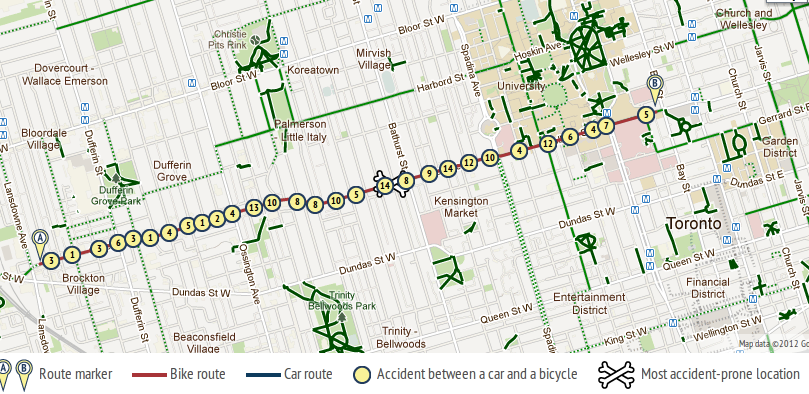It appears as if work on the separated bike lanes on Wellesley and Harbord has been slow and it's unclear if the City will meet its timeline. Transportation Services has been working on the initial phase of Wellesley but they haven't gotten far enough in either project to meet the target dates.
City Staff was directed last year, June 2011, by the Public Works and Infrastructure Committee (PWIC) to "proceed with the detailed design and consultation process for developing separated bicycle lanes on Wellesley Street with the goal of implementing them in 2012".
City staff was also directed by PWIC to start working on Harbord - Hoskin and Beverley to report in May this year:
City Council direct the Acting General Manager, Transportation Services, to commence the design phase for separated bike lanes on Harbord - Hoskin and Beverley that includes community and stakeholder consultation and consideration of the availability of parking on local side streets, with a report back to the May 2012 meeting of the Public Works and Infrastructure Committee.
This year, at the April 18, 2012 PWIC meeting, PWIC requested an update on Wellesley. We will get the official update at the May meeting. I spoke with Christina Bouchard of Transportation Services who told me that they have been doing "counts, parking surveys and traffic analysis along Wellesley, and have met with the Councillor" but that they haven't prepared any public consultation meetings as of yet. Given this pace it appears that the probability of constructing the separated Wellesley Street bike lanes in 2012 is remote.
Hopefully City Staff has advanced the design work for physically separated bicycle lanes on Harbord, Hoskins and Beverley Streets as they were directed a year ago. I haven't received any information on the progress, but given the pace of Wellesley it's likely that these streets will be even later. Anyone interested should monitor the agenda of PWIC for its May 16, 2012 meeting.
The Ward groups of wards 19, 20, 27 and 28 have become concerned regarding the slow pace and have sent a letter to PWIC (pdf) to suggest a number of improvements to the process. The letter strongly supports the separated bike lanes on Wellesley, Harbord-Hoskins and Bevereley. In addition it supports the improvements suggested by Councillor Vaughan for Ward 20. It also suggests that City Council expand the scope of planning for Wellesley to include the bikeway from Ossington to Parliament.


